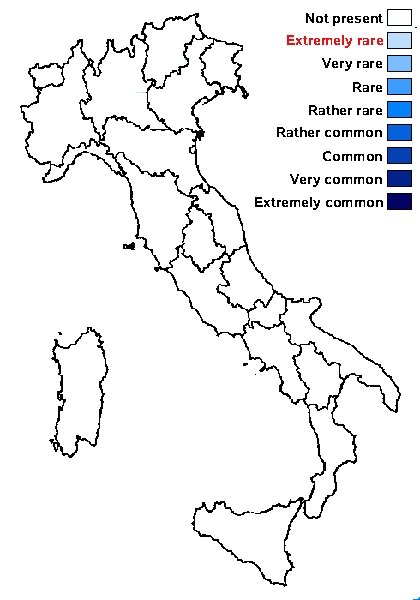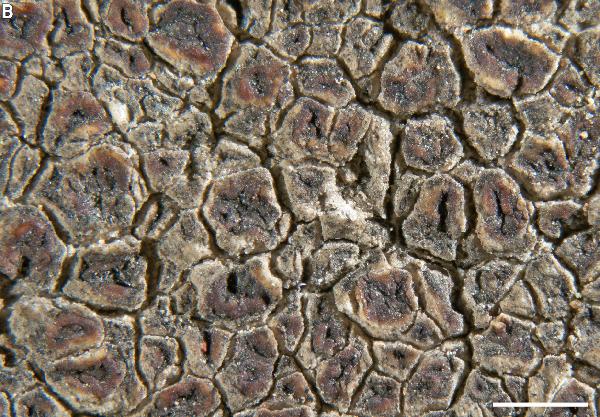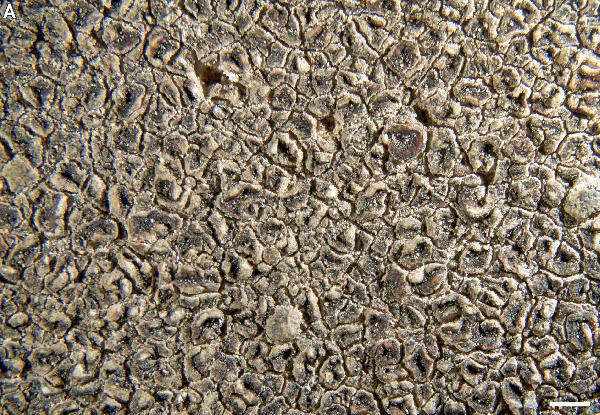Acarospora variegata H. Magn.
K. svenska Vetensk-Akad. Handl., Ser. III 7, 4: 278, 1929.
Synonyms:
Distribution: N- Frl (Knudsen & al. 2024).
Description: Thallus crustose, endo- to episubstratic, white or brownish, rimose or areolate, 2-10 cm wide, 0.5-1 mm thick the areoles 0.6-0.7 mm wide. Hyphae either scattered, 3-4 μm thick, and encrusted with crystals, or as thin as 0.5 μm, sometimes appearing as chains of c. 2 μm wide, round to oval cells, becoming gelatinized and forming a white, obscure matrix inspersed with large to very fine substrate particles and scattered algal cells. Cortex 25-40 μm thick; algal layer not coherent, the algal cells clustering around the sides of emerging apothecia and scattered beneath them; a distinct medulla is lacking. Apothecia usually elevated, 0.2- 0.3 mm across, the disc brown, usually slightly lower than the brown, epruinose margin. Proper exciple 30-60 μm wide; epithecium brownish: hymenium colourless, (100-)120-150(-170) μm high, the hymenial gel IKI+ blue, euamyloid in thick sections, in squash preparations K/I+ pale blue, but in some forms IKI+ blue turning red
in part, but becoming dirty bluish brown and blue mixed; paraphyses 1-2 μm thick, the apical cells sometimes with visible gel caps; subhymenium c. 50 μm thick, IKI+ blue in part, the hypothecium merging with subhymenium and indistinct, but sometimes visible at base of the proper exciple. Asci multispored, clavate, the apical dome K/I-, 80-120 x 10-18 μm. Ascospores 1-celled, hyaline, narrowly ellipsoid, 2-5 x c. 1 μm. Photobiont chlorococcoid. Spot tests: thallus K-, C+ red, KC+ red, P-. Chemistry: gyrophoric acid unevenly present in the epithecium and/or in the margin of apothecia and the cortex.
Note: a recently-resurrected, apparently very rare and declining species known from a few sites in Central Europe (see Knudsen & al. 2024) growing on base-rich siliceous rocks.
Growth form: Crustose
Substrata: rocks
Photobiont: green algae other than Trentepohlia
Reproductive strategy: mainly sexual
Commonnes-rarity: (info)
Alpine belt: absent
Subalpine belt: absent
Oromediterranean belt: absent
Montane belt: absent
Submediterranean belt: extremely rare
Padanian area: absent
Humid submediterranean belt: absent
Humid mediterranean belt: absent
Dry mediterranean belt: absent

Predictive model

Courtesy K. Knudsen. Source: Knudsen, K., Kocourková, J., Peksa, O., Beck, A., Velmala, S. & Wirth, V. 2024 Three poorly known Acarosporaceae of Central Europe: new reports from Czech Republic, Germany, and Italy. – Herzogia 37: 5 –15.
Acarospora variegata, Nylander 24831 (H). A – Habit of the epilithic areolate thallus. B – Detail of the thallus
areoles with elevated apothecia. Scale: A, B=1 mm.

Courtesy K. Knudsen. Source: Knudsen, K., Kocourková, J., Peksa, O., Beck, A., Velmala, S. & Wirth, V. 2024 Three poorly known Acarosporaceae of Central Europe: new reports from Czech Republic, Germany, and Italy. – Herzogia 37: 5 –15.
Acarospora variegata, Nylander 24831 (H). A – Habit of the epilithic areolate thallus. B – Detail of the thallus
areoles with elevated apothecia. Scale: A, B=1 mm.
Growth form: Crustose
Substrata: rocks
Photobiont: green algae other than Trentepohlia
Reproductive strategy: mainly sexual
Commonnes-rarity: (info)
Alpine belt: absent
Subalpine belt: absent
Oromediterranean belt: absent
Montane belt: absent
Submediterranean belt: extremely rare
Padanian area: absent
Humid submediterranean belt: absent
Humid mediterranean belt: absent
Dry mediterranean belt: absent

Predictive model

Courtesy K. Knudsen. Source: Knudsen, K., Kocourková, J., Peksa, O., Beck, A., Velmala, S. & Wirth, V. 2024 Three poorly known Acarosporaceae of Central Europe: new reports from Czech Republic, Germany, and Italy. – Herzogia 37: 5 –15.
Acarospora variegata, Nylander 24831 (H). A – Habit of the epilithic areolate thallus. B – Detail of the thallus areoles with elevated apothecia. Scale: A, B=1 mm.

 DOLICHENS
DOLICHENS

